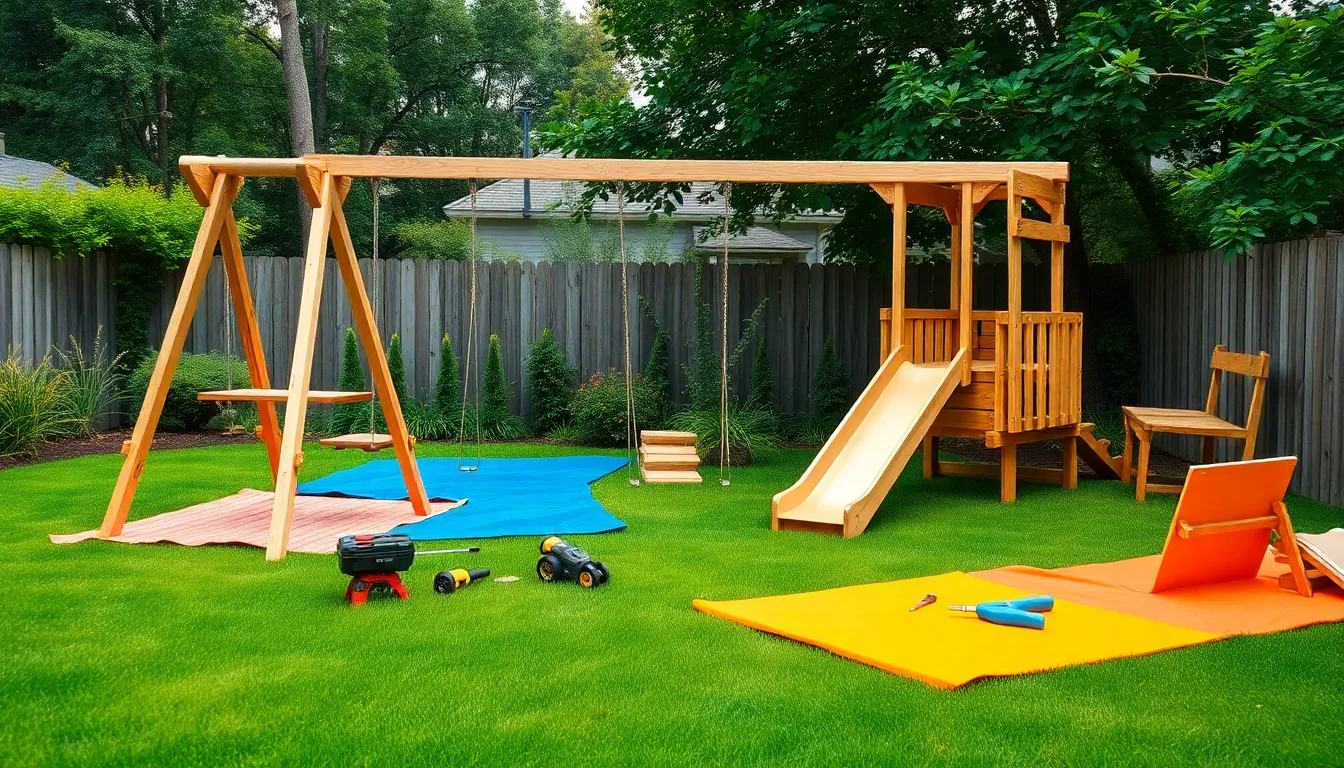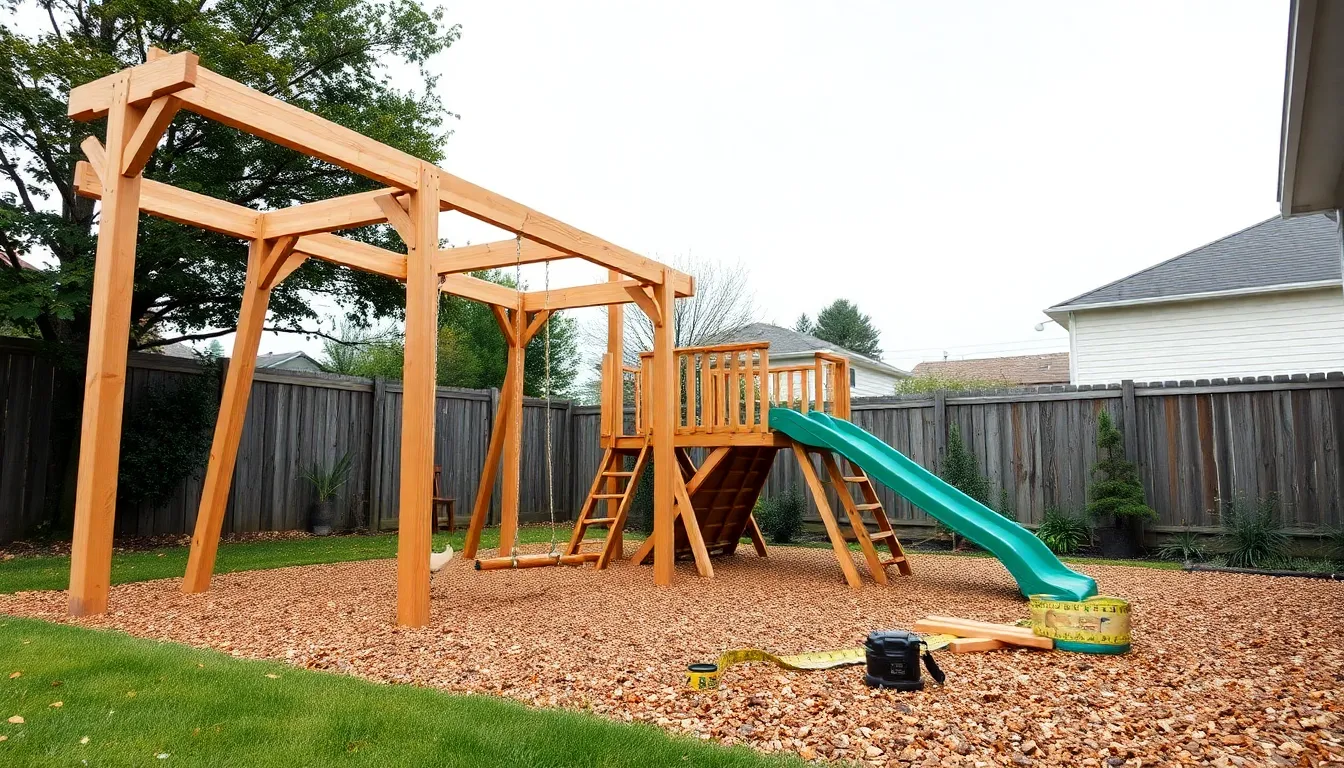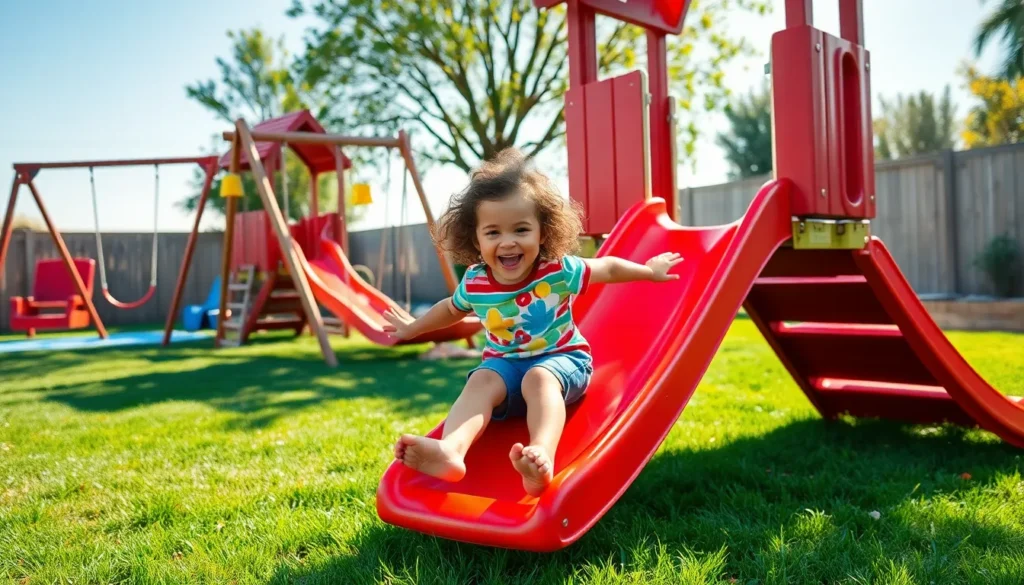Imagine transforming your backyard into a mini amusement park where giggles echo and imaginations soar. A DIY kids playground isn’t just a project; it’s a ticket to endless fun and adventure right outside your door. Why settle for a boring patch of grass when you can craft a wonderland that’ll have the neighborhood kids begging for playdates?
Table of Contents
ToggleBenefits Of A DIY Kids Playground
A DIY kids playground offers numerous advantages that enhance children’s development and well-being. These play areas not only entertain but also provide valuable learning experiences.
Encourages Physical Activity
Promoting physical activity occurs naturally in a DIY kids playground. Children engage in climbing, swinging, and running, which helps improve their physical health. Increased movement supports cardiovascular fitness and builds strength. Active play also enhances motor skills, coordination, and balance. Furthermore, playing outdoors encourages children to explore their environment. Outdoor settings provide space for free movement, allowing kids to enjoy fresh air and sunshine. Such environments cultivate a habit of being active from a young age, reducing the risk of obesity and related health issues.
Fosters Creativity And Imagination
Creating a DIY kids playground nurtures creativity and imagination. Customized elements like forts, slides, and obstacle courses inspire children to invent new games. They learn to interact with their surroundings, fostering problem-solving skills and adaptability. When kids design their playtime activities, they unleash their imaginations, which enhances cognitive development. Varied play structures invite exploration and encourage storytelling, further stimulating creative thinking. Unstructured play also allows opportunities for informal learning. Engaging with peers in imaginative scenarios promotes social skills, communication, and cooperation, vital for their growth.
Planning Your DIY Kids Playground


Creating a DIY kids playground involves careful planning to ensure both safety and fun. Prioritizing space and materials plays a critical role in the design process.
Assessing Available Space
Measuring the backyard area provides insight into how much room is available for play structures. Evaluating the terrain is another essential step to identify any slopes or obstacles.
Choosing a flat, even surface enhances safety during play. Considering the proximity to the house helps in supervision while kids play. Ensuring a distance from fences and neighbors minimizes noise disturbance, increasing harmony in the neighborhood.
Allocating sufficient space for various equipment like swings or slides encourages diverse activities. It’s vital to maintain a clear area around each installation to prevent accidents.
Selecting Appropriate Materials
Choosing the right materials influences both safety and longevity. Wood remains a popular option, often treated for durability and resistance to decay.
Metal structures, while sturdy, can heat up under the sun, which calls for protective measures. Plastic components offer a lighter alternative, ensuring safety with soft edges.
Reinforcing the playground base with mulch or rubber mats helps absorb falls, reducing injury risks. Opting for non-toxic finishes during construction enhances health standards for children.
Following local building codes ensures compliance, making safety a top priority. Seeking community resources and guidance can also streamline material selection and costs.
Design Ideas For DIY Kids Playground
Creating engaging and imaginative spaces enriches a DIY kids playground. Consider incorporating various structures that foster active play and exploration.
Climbing Structures
Climbing structures enhance physical fitness and boost confidence. A wooden climbing frame provides stability and strength while allowing for different heights. Slides offer added excitement and can connect from various climbing points. PVC pipes can create low-cost climbing walls, adding versatility and fun challenges. Rope ladders and nets encourage teamwork by allowing children to help each other ascend. Safety mats underneath these structures absorb falls, ensuring a softer landing.
Playhouses And Forts
Playhouses and forts inspire creativity and imaginative play. Designing a playhouse with multiple windows and a sturdy front door invites role-playing games. Use weather-resistant materials to ensure durability. Forts made from reclaimed pallets encourage children to build and customize their own spaces. Consider adding a roof for shade and protection from the elements, making it usable year-round. Incorporating sensory play elements, such as a chalkboard wall or sand area, further enriches the experience, allowing for diverse play opportunities.
Safety Considerations
Creating a safe DIY kids playground requires careful attention to materials and features. Prioritizing safety ensures a fun environment for children.
Choosing Safe Materials
Selecting the right materials plays a crucial role in playground safety. Wood, while popular for its durability, must be treated with non-toxic finishes to ensure children’s health. Metal structures should undergo regular inspections due to potential rust and sharp edges. Plastic components need to withstand sun exposure to avoid melting or becoming hazardous. When planning the base for play structures, consider using rubber mats or mulch to cushion falls, reducing the likelihood of injuries. It’s essential to use age-appropriate equipment that aligns with children’s developmental stages. Local building codes often specify material standards, so referring to regulations aids compliance.
Essential Safety Features
Incorporating essential safety features fosters a secure play environment. Adequate space around play equipment prevents overcrowding and promotes supervision. Grass or soft surfaces, combined with protective mats, further reduce injury risks. Installing guardrails on elevated platforms prevents falls, enhancing children’s safety. Ensuring that swings have a minimum clearance around them allows for safe movement and decreases the chance of collisions. Additional elements like rounded edges on equipment and shaded areas protect against harsh weather conditions. Regular maintenance checks help identify wear and tear, allowing for prompt repairs.
Maintenance Tips For DIY Kids Playground
Regular maintenance ensures the longevity of a DIY kids playground. Conduct weekly inspections to assess equipment integrity and identify potential hazards. Check for loose screws, damaged wood, or rusted metal components. Replace or repair any items that show signs of wear or damage promptly.
Keep the play area clean and free from debris. Raking leaves and clearing toys can prevent tripping hazards. Vacant spaces should encourage safe play, so keeping the area tidy helps children enjoy their time outdoors.
Consider inspecting safety surfaces, like mulch or rubber mats, every month. These materials can shift over time and may require replenishing to maintain a soft landing for kids. Adequate depth of safety surfaces is crucial in mitigating injury risks.
Inspect surrounding vegetation, too. Trim branches that may pose a risk if they hang low over play structures. Remove thorny plants or shrubs to create a safer environment. Ensuring trees are healthy can prevent falling branches that could injure children.
Seasons can affect equipment usability. Check swing sets and slides after heavy storms or extreme weather conditions. Ice can create slippery surfaces, while direct sun exposure may lead to heat-related dangers on certain materials.
Additionally, periodic cleaning keeps play structures looking fresh. Use mild soap and water to clean surfaces, ensuring no harmful chemicals come into contact with children. Safety should always come first when selecting cleaning products.
Finally, maintain open communication with children about playground safety. Encourage them to report any issues they notice. By fostering awareness, they’ll contribute to a safer play environment for everyone.
Creating a DIY kids playground can transform any backyard into a lively and engaging environment. It offers children a space to play freely while developing essential physical and social skills. By focusing on safety and thoughtful design, parents can ensure a playful haven that grows with their children.
Regular maintenance is key to keeping the playground safe and enjoyable. With the right planning and care, this backyard project can provide endless fun and cherished memories for families and friends. Embracing creativity and adventure in outdoor play is a rewarding experience that benefits everyone involved.





